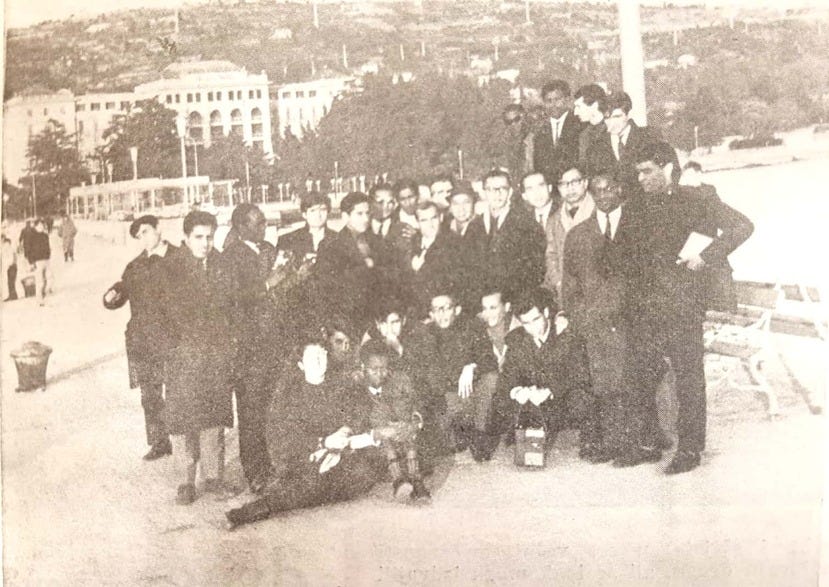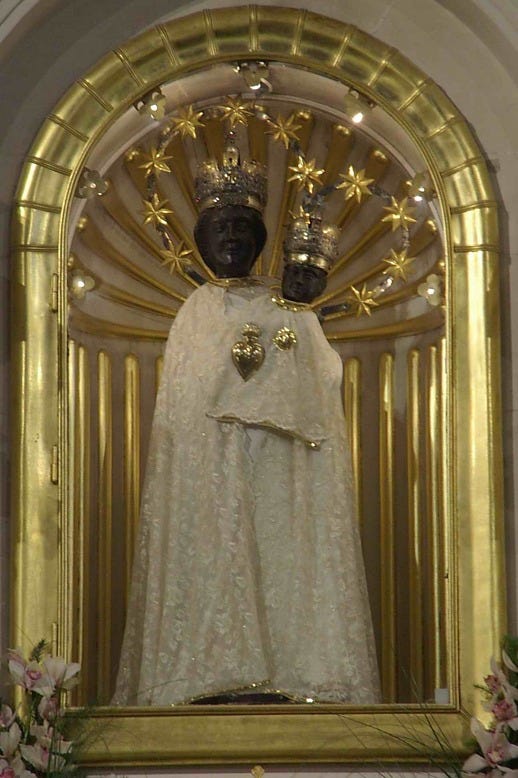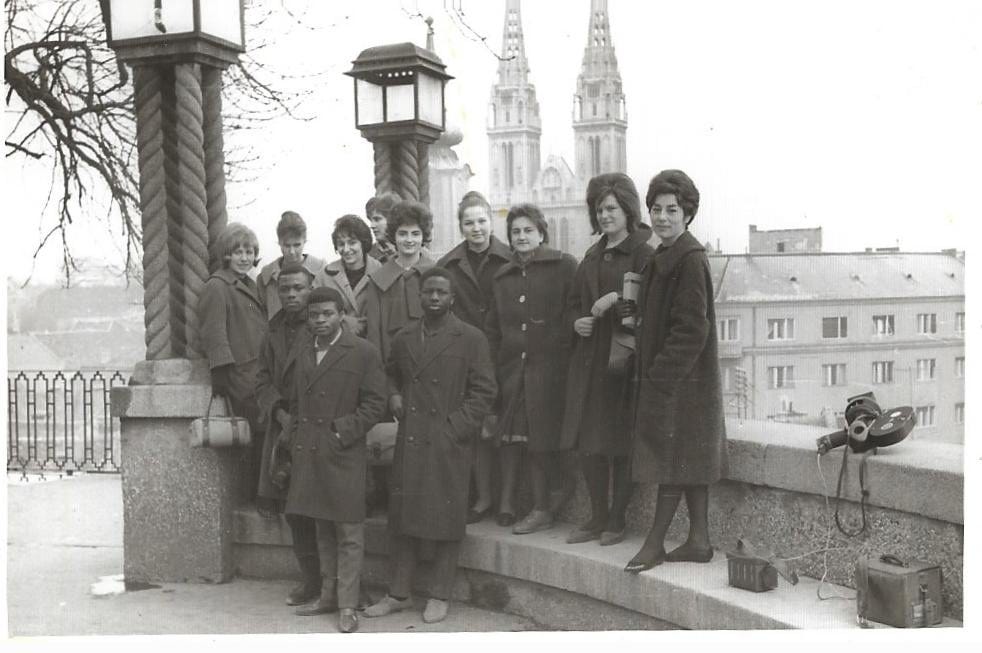Briefly on Africa in Croatia

Although there is no evidence of an African presence on Croatian territory before the 19th century, Croatia's proximity to Africa makes it possible to envision these connections going back a long way.
A statue of the Black Madonna with Child, crafted in 1499 by an unidentified artist, may be found in the small town of Marija Bistrica, located 15 kilometres from the capital city of Zagreb. The town, a well-known pilgrimage site, proudly bears the Black Madonna on its flag (“The Catholic Church’s Mysteries, Marvels, & Miracles: Our Lady of Bistrica” 2007).
Between the Habsburg Empire, Venetian rule, and the Ottoman wars in the 15th century, Croatia inherited Moorish characters and blackface customs from Venice. As a result, morčić, a carnival character in blackface and Ottoman costume, has remained the symbol of the port city of Rijeka to this day (Baker 2018).
The first Croatians arrived in Africa in the 19th century. In the days of the Austro-Hungarian Monarchy, young men from Croatia travelled around Europe, and sometimes further, in search of employment, adventure, or both. Among them was Dragutin Lerman, who from 1882 until 1896 took part in Leopold II's colonial project in the Congo. He brought back some five hundred items from the Congo, which now comprise the majority of the African collection in the Zagreb Ethnographic Museum, with a lesser collection in the City Museum in Požega (Roce 2022).
Between 1899 and 1901, the brothers Mirko and Stjepan Seljan served as Emperor Minilik's employees in Ethiopia. As military instructors, they established a town west of Lake Turkana, which is now a little village known as Selanzy. They also oversaw and mapped the southwest corner of modern-day Ethiopia. After receiving silver shields, swords, and Ethiopian silk shirts from the Emperor for the job done, they donated 133 items to the Ethnographic Museum (Molvaer 2010).
The missionary Bernardo Kohnen, who tried from 1902 to 1933 to evangelize the Shilluk people in South Sudan, contributed further items to the Ethnographic Museum's collection (“Matica Hrvatska - Hrvatska Revija 4, 2002. - MISIONAR NA GORNJEM NILU,” n.d.).
Africans officially made it to Croatia in the 20th century. At the Sorbonne in Paris in 1934, the Croatian linguist Petar Guberina met Aimé Césaire, and the two students soon became the best of friends. Consequently, in 1935, Césaire travelled to Croatia with Guberina and started writing his "Notebook of A Return to the Native Land", inspired by the Adriatic scenery as seen from Martinska. In addition to co-organizing the First Congress of Black Writers and Artists in Paris in 1956, Guberina also authored the preface to this important poem by Césaire (Humphrey 2014).
Following the brief but cruel German-Italian-installed „Independent State of Croatia”, a nazi puppet state during World War II, which was overthrown by the anti-fascist Partisan movement, Croatia became a part of the newly formed socialist Yugoslavia. Youth from the Congo, Madagascar, Algeria, Egypt, and Morocco participated in several youth work projects that helped reconstruct newly established war-damaged country in the 1940s and 1950s (Radonjić 2020).
With the introduction of scholarships for numerous developing nations and liberation movements under Yugoslavia's non-aligned policy, the first group of African students from Guinea arrived in Zagreb in 1960 (Filipović 2018). Two significant events occurred the following year: the first Non-Aligned Movement Summit in Belgrade, the then capital of Yugoslavia, and a complete issue of the magazine "Naše teme" ("Our topics") on the subject of "Moja Afrika" ("My Africa") edited by Petar Guberina and Svetozar Petrović. The Africa Research Institute was formed in 1963, again by Petar Guberina and Svetozar Petrović. It is now known as the Institute for Development and International Relations (Bosanac, Jurlina, and Pukanić 2015).

The 1960s saw the establishment of an African Section within the Department of Indology and Far East Studies at the Faculty of Humanities and Social Sciences ("O odsjeku" n.d.).
From 1964 until 1970, the Africa Research Institute published a monthly bulletin titled „Overview of Economic Developments in African and Other Developing Countries". Afrikana, a collection of 342 books, was established in 1964 as the first specialized scientific library on African matters (Bosanac, Jurlina, and Pukanić 2015).
African students from Croatian universities convened in May 1967 in Zagreb to adopt the African Student Union's statute. Several African student national and regional organizations, including those from Algeria, Ethiopia, East, Central, and South Africa, Kenya, Mali, Somalia, Sudan, Tanzania, and the United Arab Republic, had their headquarters in Zagreb's International Student Friendship Club from the 1960s until the late 1980s or early 1990s (Solidarnost 1967).
The Museum of African Art was established in 1977 in the Yugoslav capital of Belgrade, which is now in Serbia, after the African objects owned by Zdravko Pečar and Veda Zagorac, a couple of Yugoslav diplomats who spent twenty years in Africa, were offered to the Croatian town of Rovinj. However, the town expressed no interest in the collection (Sladojević 2014).
The African Student Union and the International Student Friendship Club organized Zagreb's celebration of Africa Week from 1984 to 1991 (Radonjić 2020). A double issue of the journal "Književna smotra" ("Literary Review") on African literature and culture was published in 1985. The former Africa Research Institute served as the venue for the founding of the Yugoslav Association of Africanists in 1986, which continued until 1991 (Bosanac, Jurlina, and Pukanić 2015).
Yugoslavia was violently dismantled in 1991, and Croatia became an independent nation. This was followed by hostility toward everyone different, the burning down and eviction of the International Student Friendship Club, and the dissolution of the African Student Union in 1995 (Biluš, Pavić, and Simić 2007). During the regime change, the Croatian-Kenyan filmmaker Lawrence Kiiru made two short films on African-Croatian connections: "Lerman" in 1988, which focused on Dragutin Lerman's legacy in Croatia, and "Martinska-Martinique" in 1991, which highlighted the friendship between Aimé Césaire and Petar Guberina.
The African community in Croatia began to reactivate through the founding of African-led NGOs in the 2000s. The African Diaspora in Croatia was established in 2013, followed by Afro Badinya in 2017, and PADUH – The Pan-African Association in Croatia - in 2021.
Baker, Catherine. 2018. “Transnational Formations of Race before and during Yugoslav State Socialism.” In Race and the Yugoslav Region, 94–121. Manchester University Press. https://www.manchesterhive.com/display/9781526126610/9781526126610.00009.xml.
Biluš, Marina, Ante Pavić, and Tanja Simić. 2007. “Afričke Priče Iz Hrvatske – Nacional.Hr.” Nacional. 2007. https://arhiva.nacional.hr/clanak/34814/africke-price-iz-hrvatske.
Bosanac, Gordan, Petra Jurlina, and Janko Pukanić, eds. 2015. Razvojna Suradnja Kroz Nasljeđe Pokreta Nesvrstanih =: Development Cooperation through the Legacy of the Non-Aligned Movement. Zagreb: Platforma za međunarodnu građansku solidarnost Hrvatske.
Filipović, Luka. 2018. “Pahulja Se Otopila, Ali Hamed Ne Odustaje: Prisjetite Se Burne Karijere Bivšeg DJ-a, Modnog Maga i Facebook Revolucionara.” Tportal.Hr. 2018. https://www.tportal.hr/biznis/clanak/pahulja-se-otopila-ali-hamed-ne-odustaje-prisjetite-se-burne-karijere-bivseg-dj-a-modnog-maga-i-facebook-revolucionara-foto-20180207.
Humphrey, Anja Jovic. 2014. “Aimé Césaire and ‘Another Face of Europe.’” MLN 129 (5): 1117–48.
“Matica Hrvatska - Hrvatska Revija 4, 2002. - MISIONAR NA GORNJEM NILU.” n.d. Accessed January 6, 2024. https://www.matica.hr/hr/328/misionar-na-gornjem-nilu-20901/.
Molvaer, Reidulf K. 2010. “The Seljan Brothers and the Expansionist Policies of Emperor Minïlik II of Ethiopia.” International Journal of Ethiopian Studies 5 (2): 79–90.
“O Odsjeku.” n.d. Katedra za indologiju (blog). Accessed December 5, 2021.
https://indolog.ffzg.unizg.hr/?page_id=26.
Radonjić, Nemanja. 2020. “Slika Afrike u Jugoslaviji: (1945-1991).” PhD Thesis, Belgrade: University of Belgrade. https://nardus.mpn.gov.rs/handle/123456789/17768?show=full.
Roce, Damjan. 2022. “Reprezentacija Hrvatskog Istraživača Dragutina Lermana u Javnom i Znanstvenom Diskursu.” Master thesis, Zagreb: University of Zagreb.
Sladojević, Ana. 2014. Muzej Afričke Umetnosti: Konteksti i Reprezentacije. Belgrade: Muzej afričke umetnosti.
Solidarnost. 1967. “Sastanci i Stručna Predavanja,” 1967, 14:15 edition.
“The Catholic Church’s Mysteries, Marvels, & Miracles: Our Lady of Bistrica.” 2007. The Catholic Church’s Mysteries, Marvels, & Miracles (blog). December 29, 2007. http://holycardlover.blogspot.com/2007/12/our-lady-of-bistrica.html.
“Upoznajmo se s afrikanistikom u Hrvatskoj.” 2013. Kulturzativ (blog). May 24, 2013. https://zeljkasvenda.wordpress.com/2013/05/24/upoznajmo-se-s-afrikanistikom-u-hrvatskoj/.






